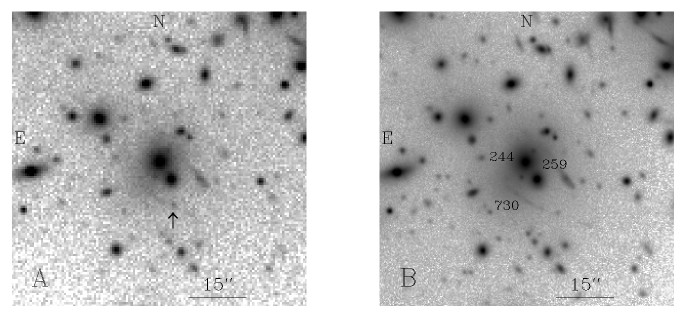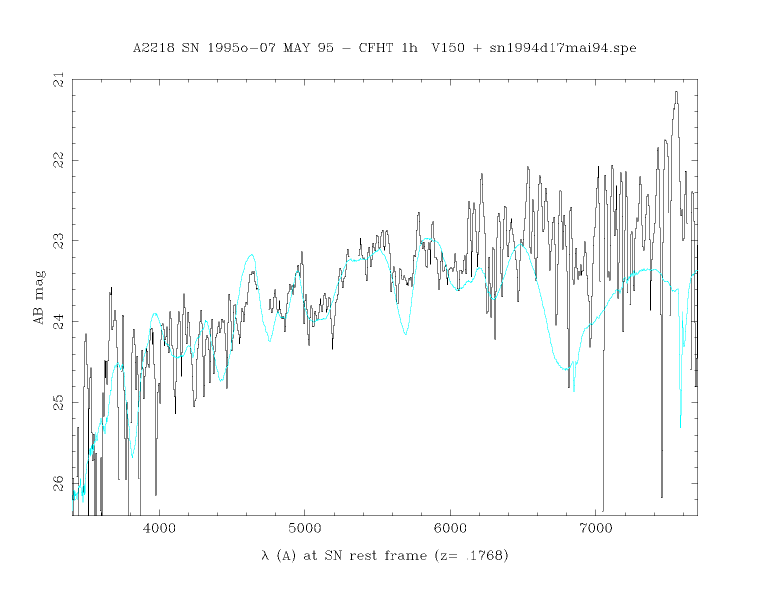SN 1995o: A supernova in the intracluster medium of Abell 2218
(first posted in 1995)
Based on observations made with the William Herschel Telescope (operated on the island of La Palma by the Royal Greenwich Observatory in the spanish Observatorio del Roque de los Muchachos of the Instituto de Astrofísica de Canarias) and with the Canada-France-Hawaii Telescope
By J.F. Le Borgne1
with the collaboration of B. Sanahuja2,3, R. Pelló1,
S. Maddox4,
Y. Mellier9, C. Soubiran5, J.C. Cuillandre8,
T.M.D. Ebbels6 and E. Friel7.
1 IRAP, Observatoire Midi-Pyrénées, Toulouse, France
2 Departament d'Astronomia i Meteorologia, Universitat de Barcelona, Spain
3 Laboratori d'Astrofísica del IEC, Barcelona, Spain
4 Royal Greenwich Observatory, Cambridge, U.K.
5 Observatoire de Bordeaux, Bordeaux, France
6 Institute of Astronomy, Cambridge, U.K.
7 Maria Mitchell Observatory, USA
8 Canada-France-Hawaii Telescope, Hawaii, USA
9 Institut d'Astrophysique, Paris, France
Abstract
The supernova 1995o was discovered with the WHT in the core of the cluster of galaxies Abell 2218 at a redshift of 0.1756. The supernovais at 7" (projected distance 18kpc with Ho=75, qo=0.5) from the closest cluster galaxy and is marginally in the extended halo of a giant elliptical galaxy located at 12" (31kpc). Its V magnitude at the time of discovery was about 23.7. A spectrum of the supernova obtained with the CFHT confirms it belonging to the cluster. This spectrum is characteristic of SNI type supernova about 50-70 days after explosion.
Observations
We present the serendipitous discovery of a supernova in
the core of the cluster of galaxies Abell 2218 (Abell et al. 1989).
Abell 2218 is a rich cluster of galaxies at a redshift of 0.1756
(Le Borgne et al. 1992) known for its spectacular system of arcs
(Pelló et al., 1992, Kneib et al., 1995, Kneib et al., 1996,
Ebbels et al., 1996) (see the HST
image)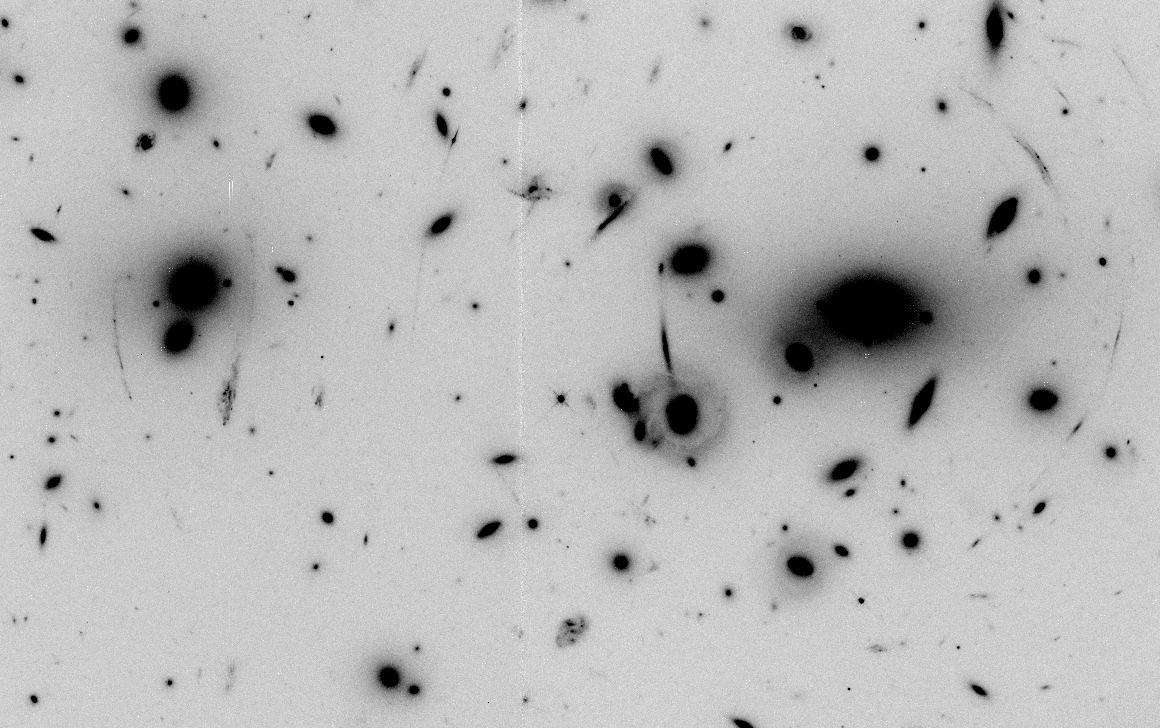 and for the detection of the Sunyaev-Zeldovich effect
(see e.g. Klein et al., 1991). The supernova has been discovered
on 2 ccd frames taken with the 4.2m William Herschel Telescope on
1995 may 3 at 03:10 UT and 03:16 UT. See report in
IAUC 6172. These frames were 60s white light frames used for
the design of multi-object spectroscopy masks (ccd
tektronix 1024x1024 on LDSS2, 10'x10'). The suspected new object
was located at about 1" from the presumed gravitational arc #730 of
A2218 (Fig. 1) belonging to the secondary gravitational arc system
around galaxy #244 (Pelló,1992 et al.). The closest cluster
galaxy is #259 at 7" and the bright cluster galaxy #244 is at 12".
The coordinate transformation coefficients were computed by least square
fitting of the position of 7 stars from the HST guide star catalogue
in the may 3 WHT frames. The standard deviation of the residuals on
the position of the gsc stars is about 0.3". The coordinates of the
supernova, computed with these coefficients, are:
and for the detection of the Sunyaev-Zeldovich effect
(see e.g. Klein et al., 1991). The supernova has been discovered
on 2 ccd frames taken with the 4.2m William Herschel Telescope on
1995 may 3 at 03:10 UT and 03:16 UT. See report in
IAUC 6172. These frames were 60s white light frames used for
the design of multi-object spectroscopy masks (ccd
tektronix 1024x1024 on LDSS2, 10'x10'). The suspected new object
was located at about 1" from the presumed gravitational arc #730 of
A2218 (Fig. 1) belonging to the secondary gravitational arc system
around galaxy #244 (Pelló,1992 et al.). The closest cluster
galaxy is #259 at 7" and the bright cluster galaxy #244 is at 12".
The coordinate transformation coefficients were computed by least square
fitting of the position of 7 stars from the HST guide star catalogue
in the may 3 WHT frames. The standard deviation of the residuals on
the position of the gsc stars is about 0.3". The coordinates of the
supernova, computed with these coefficients, are:
The proximity of the arc #730 at 1" (a galaxy potentially at a redshift of the order of 1) and the great distance from bright objects, motivated the obtention of a spectrum to determine its redshift. If a supernova appears in a triple image arc like #730 the time delays between the 3 images could have been be measured (Kovner, 1988). According to Kovner (1988), a typical supernova at redshift 1 would have a magnitude R=25 but would appear with R=20-23 because amplified by the lens. Thanks to C. Soubiran and E. Friel, spectra of the new object were then obtained with the 3.6m Canada-France-Hawaii telescope on 1995 may 7: 2 30mn spectra with a V150 grating were obtained at 12:31 UT and 13:11 UT. A loral ccd 2048X2048 was mounted on the instrument MOS. The dispersion is 6.9 Å/pixel. The wavelength was limited by the ccd+intrument+atmosphere transmission: 3500-9000Å. The smoothed sum of the 2 spectra is displayed in figure 2.
Unfortunately for the lens hypothesis, the spectrum showed features
which could be identified as being at the redshift of the cluster
(see below). Despite of its closeness to the arc and its large
distance from any cluster galaxy, the supernova belongs to the
cluster. The supernova is at a projected distance of 18kpc from
the closest cluster galaxy #259 and is marginally in the extended
halo of a giant elliptical galaxy #244 (2d galaxy in
luminosity in the cluster) located at a projected distance of
31kpc.
Afterwards, ccd frames were obtained at CFHT on 1995 may 27 with
the ccd camera MOCAM and a V filter, and at WHT with LDSS2 and no
filter on 1995 may 26, 27, 28 and june 1st. See table for
a summary of the observations.
| date | UT | Julian Day | telescope | filter/ | exposure time (s) | |||||
|---|---|---|---|---|---|---|---|---|---|---|
| 2400000+.. | grating | time (s) | ||||||||
| 03/05/95 | 03:10 | 49840.6321 | WHT | none | 60 | |||||
| 03:16 | 49840.6362 | WHT | none | 60 | ||||||
| 07/05/95 | 11:20 | 49844.9728 | CFHT | none | 60 | |||||
| 12:02 | 49845.0017 | CFHT | none | 60 | ||||||
| 12:15 | 49845.0106 | CFHT | none | 60 | ||||||
| 12:31 | 49845.0219 | CFHT | V150 | 1800 | ||||||
| 13:11 | 49845.0492 | CFHT | V150 | 1800 | ||||||
| 26/05/95 | 03:50 | 49863.6598 | WHT | none | 60 | |||||
| 27/05/95 | 03:57 | 49864.6652 | WHT | none | 60 | |||||
| 04:01 | 49864.6675 | WHT | none | 60 | ||||||
| 04:24 | 49864.6839 | WHT | none | 60 | ||||||
| 04:32 | 49864.6889 | WHT | none | 60 | ||||||
| 04:44 | 49864.6973 | WHT | none | 60 | ||||||
| 10:27 | 49864.9354 | CFHT | V | 600 | ||||||
| 23:50 | 49865.4931 | WHT | none | 60 | ||||||
| 23:56 | 49865.4975 | WHT | none | 60 | ||||||
| 28/05/95 | 03:34 | 49865.6493 | WHT | none | 100 | |||||
| 01/06/95 | 22:23 | 49870.4331 | WHT | none | 60 |
The last observations of A2218 before the appearance of the supernova seems to be the HST WFPC2 image obtained in september 1994 (Kneib et al., 1996) and near IR J and K frames taken on 1994 Aug. 18 with the Canada-France-Hawaii Telescope (CFHT).
To build a light curve, we compute the difference of magnitude between the supernova and the star #346 (see Le Borgne et al. 1992 for identification). Next table gives averages on a night of these differences of magnitude. The table also gives a V magnitude on 1995 may 27 for the only frame taken with a filter and which can be calibrated. On figure 3 the points from WHT/LDSS2 can be compared to each other because they were obtained with the same telescope and ccd. Altough in both case the measures are made without filters, the comparison with the points of CFHT/MOS (loral ccd) and of CFHT/MOCAM is dangerous since the ccds and telescopes are differents. As well the comparison with the V filter measurement is useless. The decrease of magnitude from 1995 may 3 to 1st of june can be estimated as 0.5 magnitude, altough the point of 26/05/95 is unexplained.
| date | Julian Day | telescope | filter | number of | Δm | V | ||||||
|---|---|---|---|---|---|---|---|---|---|---|---|---|
| 2400000+.. | points | |||||||||||
| 03/05/95 | 49840.634 | WHT | none | 2 | 2.60 | - | ||||||
| 07/05/95 | 49844.995 | CFHT | none | 3 | 2.88 | - | ||||||
| 26/05/95 | 49863.660 | WHT | none | 1 | 3.50 | - | ||||||
| 27/05/95 | 49864.680 | WHT | none | 5 | 3.07 | - | ||||||
| 27/05/95 | 49864.935 | CFHT | V | 1 | 3.45 | 24.2 | ||||||
| 28/05/95 | 49865.546 | WHT | none | 3 | 2.98 | - | ||||||
| 01/06/95 | 49870.433 | WHT | none | 1 | 3.12 | - |
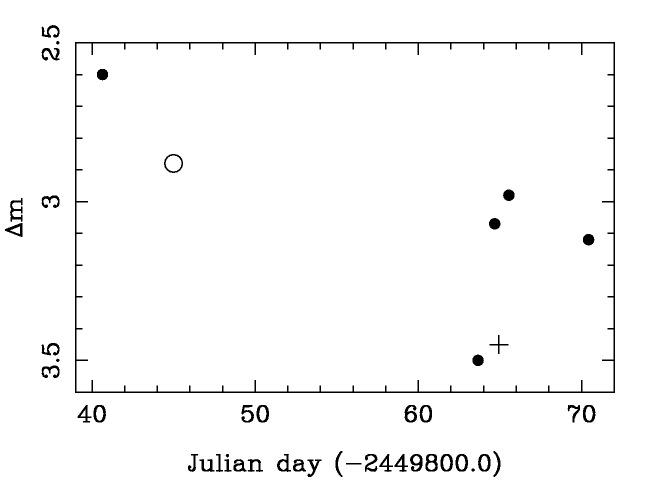
Interpretation of the spectrum and light curve
The slope of 0.5 magnitude in 30 days (observed from hearth), that is 2 mag (100 days) in the supernova rest-frame, is typical of the slope of a SNI after the inflection point which appears some 30 rest-frame days after maximum (Pskovskii, 1984). Linder et al. (1988) and Leibundgut (1990) forsee a V mag of 20.2 for a SNI at z=0.1756 at maximum. The observed magnitude of 24.2 on 1995 may 27 could have occured about 90 rest-frame days after maximum of a typical SNI. As a consequence we can estimate from this that the maximum of light could have been observed about JD49759 (about 1995 february 15) and that its first observation with WHT occured 82 days after maximum (70 rest-frame days). The spectrum should have been obtained with the CFHT about 73 rest-frame days after maximum.
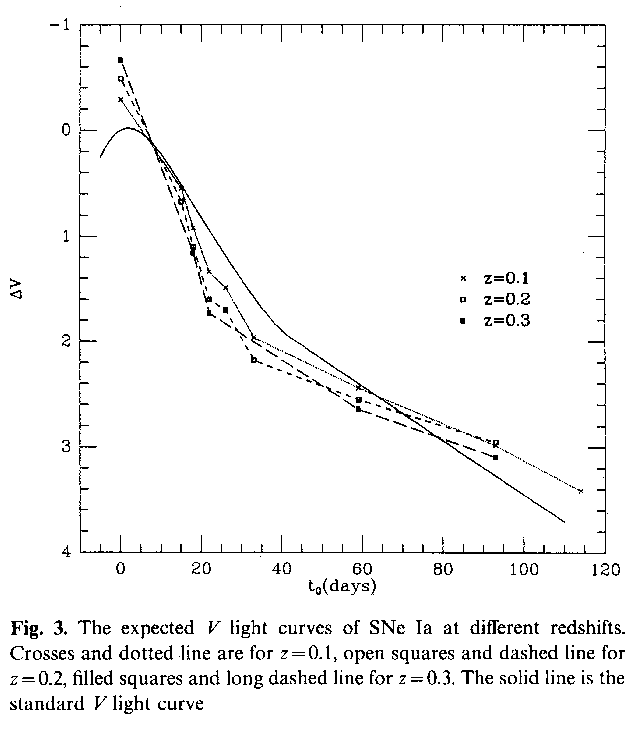
The spectrum is very similar to the spectra of the SN1989B in NGC3627 at 50 and 71 days after maximum as shown in figure 6 of Wells et al. (1994) and of SN1992A and SN1990N at 50 days after maximum (figures 10 and 11 of Kirshner et al. (1993). Emissions at the redshift of A2218 corresponding to features at about 3712Å, 4645Å, 4944Å, 5511Å and 5848Å in the spectra of the type-Ia supernova 1989B were identified in the spectra of SN 1995O at 4362Å, 5458Å, 5809Å, 6475Å and 6871Å. Likewise, the absorptions in SN 1989B at about 4862Å, 5047Å, 5692Å and 6020Å were identified in SN 1995O at 5713Å, 5930Å, 6688Å and 7073Å.
Galaxy #244 has a redshift of 0.1768 and galaxy #259 a redshift of 0.1646 (Le Borgne et al. 1992). The difference of redshift between the two galaxies correspond to 5Å at 5000Å. This is less than 1 pixel in the spectrum and it then impossible to discriminate from the spectrum if the supernova belongs to #244 or to #259.
Figure 5 shows the position of the supernova on the HST image, very close to arc #730.
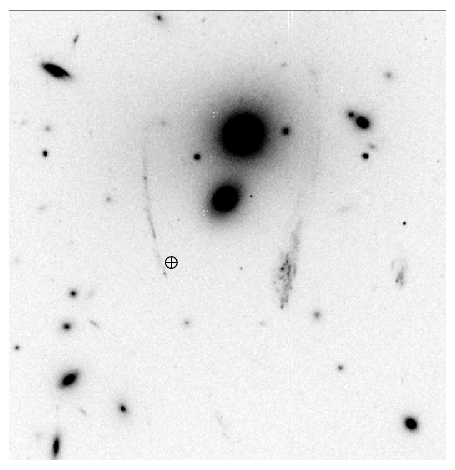
References
G. O. Abell, H. G. Corwin, R. P. Olowin, 1989, ApJS 70, 1.
T. M. D. Ebbels, J.-F. Le Borgne, R. Pelló, R. S. Ellis, J.-P. Kneib, I. R. Smail, B. Sanahuja, 1996, MNRAS
R. P. Kirshner, D. J. Jeffery, B. Leibundgut et al., 1993, ApJ 415, 589
U. Klein, Y. Rephaeli, R. Schlickeiser, R. Wielebinski, 1991, A&A 244, 43.
J.-P. Kneib, Y. Mellier, R. Pelló, J. Miralda-Escudé, J.-F. Le Borgne, H. Böhringer, J.-P. Picat, 1995, A&A, 303, 27
J.-P. Kneib, R. S. Ellis, I. R. Smail, W. J. Couch, R. Sharples, 1996, ApJ
I. Kovner, B. Paczynski, 1988, ApJ 335, L9
J.-F. Le Borgne, R. Pelló , B. Sanahuja, 1992, A&AS 95, 87.
B. Leibundgut, 1990, A&A 229, 1.
E. V. Linder, P. Schneider, R. V. Wagoner, 1988, ApJ 324, 786
R. Pelló, J.-F. Le Borgne, B. Sanahuja, G. Mathez, B. Fort, 1992, A&A 266, 6.
Yu. P. Pskovskii, 1984, Sov. Astr 28, 658.
L. A. Wells, M. M. Phillips, N. B. Suntzeff et al., 1994, AJ 108, 2233

